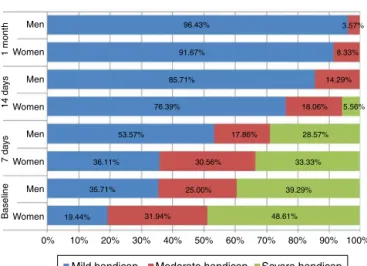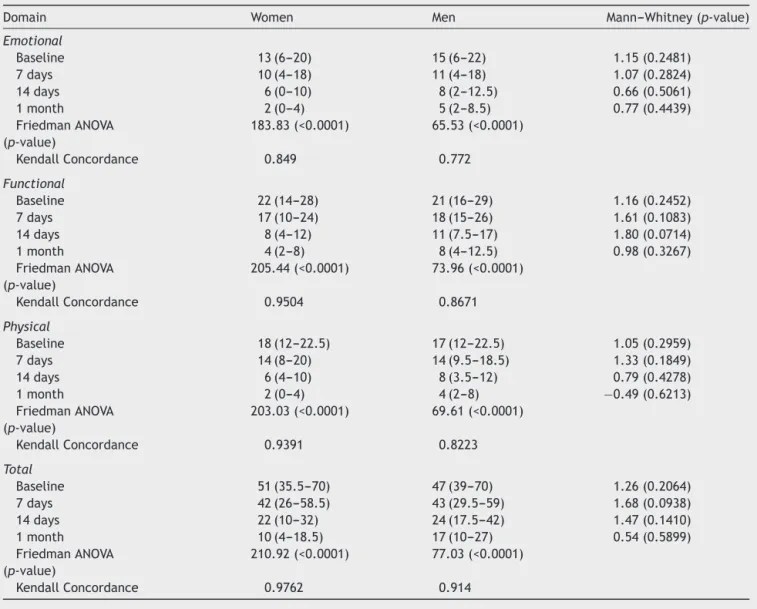www.bjorl.org
Brazilian
Journal
of
OTORHINOLARYNGOLOGY
ORIGINAL
ARTICLE
Health-related
quality
of
life
and
disability
in
patients
with
acute
unilateral
peripheral
vestibular
disorders
夽
Maria
Petri
a,
Magdalena
Chiril˘
a
a,∗,
Sorana
D.
Bolboac˘
a
b,
Marcel
Cosgarea
aaIuliuHatieganuUniversityofMedicineandPharmacy,DepartmentofOtorhinolaryngology,Cluj-Napoca,Romania
bIuliuHat¸ieganuUniversityofMedicineandPharmacy,DepartmentofMedicalInformaticsandBiostatistic,Cluj-Napoca,Romania
Received4May2016;accepted7August2016 Availableonline24August2016
KEYWORDS
Unilateralperipheral vestibulardisorders; DHI;
SF-36; HRQoL
Abstract
Introduction:Health-relatedqualityoflifeisusedtodenotethatportionofthequalityoflife
thatisinfluencedbytheperson’shealth.
Objectives: Tocomparethehealth-relatedqualityoflifeofindividualswithvestibulardisorders
ofperipheraloriginbyanalyzingfunctional,emotionalandphysicaldisabilitiesbeforeandafter vestibulartreatment.
Methods:A prospective, non randomized case-controlled study was conduced in the ENT
Department,betweenJanuary2015andDecember2015.Allpatientsweresubmittedto cus-tomizea36itemofhealthsurveyonqualityoflife,shortform36healthsurveyquestionnaire (SF-36)andtheDizzinessHandicapInventoryforassessingthedisability.Individualswere diag-nosed withacuteunilateral vestibularperipheral disordersclassifiedin5groups:vestibular neuritis,MénièreDisease,BenignParoxysmalPositionalVertigo,cochlear-vestibular dysfunc-tion (other thanMénière Disease),or othertype of acuteperipheral vertigo (as vestibular migraine).
Results:TherewasastatisticalsignificantdifferenceforeachparameterofDizzinessHandicap
Inventoryscore(theemotional,functionalandphysical)betweenthebaselineandonemonth bothinmenandwomen,butwithanystatisticalsignificantdifferencebetween7daysand14 days.ItwasfoundastatisticalsignificantdifferenceforalleightparametersofSF-36score between thebaselineandonemonth laterbothinmenandwomen;theexceptionwasthe menmentalhealthperception.ThecorrelationbetweentheDizzinessHandicapInventoryand the SF-36scores accordingto diagnosticstype pointed outthattheSpearman’s correlation coefficientwasmoderatecorrelatedwiththetotalscoresoftheseinstruments.
夽 Pleasecitethisarticleas:PetriM,Chiril˘aM,Bolboac˘aSD,CosgareaM.Health-relatedqualityoflifeanddisabilityinpatientswithacute unilateralperipheralvestibulardisorders.BrazJOtorhinolaryngol.2017;83:611---8.
∗Correspondingauthor.
E-mail:Magdalena.Chirila@umfcluj.ro(M.Chiril˘a).
PeerReviewundertheresponsibilityofAssociac¸ãoBrasileiradeOtorrinolaringologiaeCirurgiaCérvico-Facial.
http://dx.doi.org/10.1016/j.bjorl.2016.08.004
Conclusion:TheDizzinessHandicapInventoryandtheSF-36areuseful,provedpracticaland validinstrumentsforassessingtheimpactofdizzinessonthequalityoflifeofpatientswith unilateralperipheralvestibulardisorders.
© 2016 Associac¸˜ao Brasileira de Otorrinolaringologia e Cirurgia C´ervico-Facial. Published by Elsevier Editora Ltda. This is an open access article under the CC BY license (http:// creativecommons.org/licenses/by/4.0/).
PALAVRAS-CHAVE
Distúrbios vestibulares periféricos unilaterais; DHI; SF-36; QVRS
Qualidadedevidarelacionadaàsaúdeeincapacidadeempacientescomdistúrbios vestibularesperiféricosunilateraisagudos
Resumo
Introduc¸ão:Qualidadedevidarelacionadosàsaúdeéutilizadaparadesignaraparteda
quali-dadedevidaqueéinfluenciadapelasaúdedoindivíduo.
Objetivos: Comparara qualidadede vidarelacionada àsaúde de indivíduoscom distúrbios
vestibulares deorigem periférica,analisando incapacidadesfuncionais, emocionais efísicas anteseapósotratamentovestibular.
Método: Umestudodecaso-controleprospectivo,nãorandomizadofoiconduzidono
Departa-mentodeOtorrinolaringologia,entrejaneirode2015edezembrode2015.Todosospacientes foramsubmetidosaumapesquisadesaúdepersonalizadade36itenssobrequalidadedevida, aoformulárioabreviadodeavaliac¸ãodesaúde36(SF-36)eaoDizzinessHandicapInventory para avaliar a incapacidade. Os indivíduos foram diagnosticados com distúrbios vestibu-laresperiféricosunilateraisagudos,classificadosem5grupos:neurite vestibular,Doenc¸ade Ménière,vertigemposicionalparoxísticabenigna,disfunc¸ãocócleo-vestibular(excetoDoenc¸a deMénière),ououtrotipodevertigemperiféricaaguda(comoenxaquecavestibular).
Resultados: Houveumadiferenc¸aestatisticamentesignificanteparacadaparâmetrodeescore
noDizzinessHandicapInventory(emocional,funcionalefísico)entreaavaliac¸ãobasaledepois
deummês,tantoemhomensquantoemmulheres,massemdiferenc¸aestatísticasignificativa entre7diase14dias.Foiencontradaumadiferenc¸aestatisticamentesignificanteparatodos osoito parâmetrosdoescorenoSF-36entre aavaliac¸ãobasal eum mêsmaistarde, tanto emhomensquantoemmulheres;aexcec¸ãofoiapercepc¸ãodesaúdementalnoshomens.A correlac¸ãoentreDizzinessHandicapInventoryeoSF-36deacordocomotipodediagnóstico mostrouqueocoeficientedecorrelac¸ãodeSpearmanfoimoderadoquandocorrelacionadocom oescoretotaldessesinstrumentos.
Conclusão:ODizzinessHandicap Inventory eoSF-36demonstraram serinstrumentos úteis,
práticoseválidos paraavaliaroimpactodatonturanaqualidadedevidadepacientescom distúrbiosvestibularesperiféricosunilaterais.
© 2016 Associac¸˜ao Brasileira de Otorrinolaringologia e Cirurgia C´ervico-Facial. Publicado por Elsevier Editora Ltda. Este ´e um artigo Open Access sob uma licenc¸a CC BY (http:// creativecommons.org/licenses/by/4.0/).
Introduction
Quality of life is defined as an individual perception of her/hisposition in life in the context of the culture and value systems in which she/he lives, and it encompasses abroadspectrumofdomainsincludinghealthstatus, eco-nomic resources, work status, relationships, and leisure activities.1Health-RelatedQualityofLife(HRQoL)isusedto denotethatportionofthequalityoflifethatisinfluenced bytheperson’shealth.
Vertigoor dizziness is oneof the mostcommon condi-tions thatbrings patients to emergencyand itsincidence increaseswithage.2Despitealifetimeprevalenceof dizzi-nessandvertigoestimatedat20---30%and1-yearprevalence estimate for vertigo of 4.9%, the healthcare burden of vertigoisstillrelativelyunder-reported duetothe unpre-dictability of attacks and the nature of the disease.3 An individual’s progress or lack of progress in vestibular
rehabilitation isusuallymeasured byobservingchanges in motionintolerance,balance,functionalabilitiesandmore recently, health-related quality of life.4 Currently avail-ableconventionaldiagnostictests(i.e.bed-sidevestibular examination, videonystagmography, caloricand rotational tests,andposturography)areinadequateforevaluatingthe debilitating effects associated with vestibular disorders.5 Consequently, various questionnaires (such as General DepressionScale, Strait-Trait AnxietyIndex,DynamicGait Index, the Functional Gait Assessment, the Balance Error Scoring System)6 have been developed in an attempt to quantify the self-perceived health status in vestibular patientswithdizzinessandimbalance.
toanindividual’sfunctionalwell-being;ithasbeenwidely usedinstudiesoftheoutcomeforchronicdiseases,andit facilitatescomparisonoftheclinicalhealthofpatientswith theaveragestandardizedscoresofthegeneralpopulation.7 The Dizziness HandicapInventory(DHI),a disease-specific questionnaire,wasdevelopedforindividualswithdizziness orbalanceproblemsandmeasureshowvertigoand disequi-librium (imbalance) affect an individual’s quality of life; this is a25 item scale that wasdesigned toevaluate the effectofdizzinessandunsteadinessonthefunctional, emo-tional,and physical aspects of everyday life.8 The ability to detect the minimal clinical change in a variable over timeisresponsiveness;the DHIandtheSF-36provide the opportunity to compare the responsiveness of these two measurement instruments in HRQoL of patients with ves-tibulardysfunctioning.9
The aimof thisstudy wastodeterminatethe relation-ship between disabilityand HRQoLin patients withacute unilateral vertigo of peripheral origin by analyzing func-tional,emotional,andphysicaldisabilitiesbeforeandafter vestibulartreatment.
Methods
Aprospective,nonrandomizedstudywasconductedon indi-vidualsdiagnosedwithacuteunilateralvestibularperipheral disorders. All patients were submitted to customizea 36 item of health survey on quality of life, short form 36 healthsurveyquestionnaire(SF-36)andtheDizziness Hand-icapInventory(DHI)forassessingthedisability.Allpatients answeredtheSF-36andDHIbothatthebeginningandthe endofthefollowup(SF-36:baseline&1monthfollow-up; DHI:baseline,7days,14daysand1monthfollow-up).The studywasapprovedbytheEthicsCommitteeofUniversity ofMedicineandPharmacy(Referencen◦200/8.05.2015).
Theunilateralvestibularperipheraldisorderswere classi-fiedbytypeofperipheralvestibulardisturbancein5groups: vestibular neuritis, Ménière disease, Benign Paroxysmal Positional Vertigo (BPPV), cochlear-vestibular dysfunction (otherthanMénièredisease),orothertypeofacute periph-eralvertigo(asvestibularmigraine).
Vestibularneuritiswasdiagnosedasanacute,sustained dysfunctionofunilateral peripheralvestibularsystemwith secondary nausea, vomiting, vertigo, and preserved audi-tory function. Symptoms typically started with a sudden attackofvertigo(asensationofswayingorspinning)or dizzi-ness,oftenaccompaniedbydifficultywithvisionorbalance and couldrangefrom mild dizzinesstoa violentspinning orswayingsensation.Themostseveresymptomsgenerally lastedforamatterofdays.Less-severesymptomsgradually diminishedoverseveralweeks,andsomepeoplerecovered completely.
A typical attack of Meniere’s disease waspreceded by fullnessin oneear;rarely occurred hearingfluctuationor changesintinnitus.AMeniere’sepisodeor‘‘attack’’ gener-allyinvolved severevertigo (spinning), imbalance,nausea and vomiting as well as acute reduction of hearing. The averageattacklastedtwotofourhours.
BPPV included dizziness or vertigo, lightheadedness, imbalance,andnausea.Activitieswhichbringonsymptoms willvaryamongpersons,butinourpatientssymptomswere
almostalways precipitatedby achange of positionofthe headwithrespecttogravity.
Cochlear-vestibular dysfunction included patients with acute vertigo of peripheral origin associated hearing loss oracutetinnituswhowerenoteligibleforMenieredisease group.
Othertypeofacuteperipheralvertigoreferstovertigo associated migraine. The clinical presentation of vesti-bularsymptomsthatoftencorrelatewithmigraineincluded: dizziness; motionintolerance withrespectto head,eyes, and/orbody;spontaneousvertigoattacks(often accompa-nied by nauseaand vomiting); diminished eye focus with photosensitivity;soundsensitivityandtinnitus;balanceloss andataxia;cervicalgia(neckpain)withassociatedmuscle spasmsintheuppercervicalspine musculature;confusion with altered cognition; spatial disorientation; and anxi-ety/panic.
These subjects attended the ENT Department, Emer-gencyCountyHospital,betweenJanuary2015and Decem-ber 2015. The patients signed an informed consent form and accepted both the participation and the follow-up schedulepriortoenrolment.Allthepatientswere submit-ted to a complete ENT evaluation and complete medical history,neurologicalexamination, otologicaland audiolog-ical assessment with impedance measures and auditory evokedpotentials,vestibulartests,including videonystag-mography,calorictests,computertomographyormagnetic resonance imaging as appropriate. There were excluded: individuals who presented central vestibular alterations; ‘‘dizziness’’withoutadiagnosisofacuteunilateral periph-eral vestibular disorder; people with clinical diagnosis of neurological degenerative diseases and/or cerebellar disease or posttraumatic vertigo; patients received prior vestibular rehabilitation or currently receiving vestibular rehabilitation, or using antivertiginous medication before presentation. Information was collected as demographic characteristics(age,gender,origin)andclinicaldata(type of peripheral vestibular disorder: BPPV, Ménière, other cochlear-vestibular dysfunction, vestibular neuritis, and othertypesofacuteperipheralvertigo),useofmedication (yesorno)andassociatedcomorbidities.
The Short-Form Health Survey (SF-36) is a validated short-form health questionnaire composed of 36 items.10 SF-36 measures health on eight multi-item dimensions, coveringfunctional status,wellbeing,andoverall evalua-tionof health: functionalstatus withphysical functioning (10 items), social functioning (2 items), role limitations (physical problems) (4 items), role limitations (emotional problems)(3items),wellbeingwithmentalhealth(5items), vitality(4items), pain(2items)andoverall evaluationof healthwithgeneralhealth perception(6 items).Foreach variable,itemscoresarecoded,summed,andtransformed onascalefrom0(worstpossiblehealthstatemeasuredby thequestionnaire)to100(bestpossiblehealthstate).Itis agenerichealthmeasure,ratherthandisease-specific.
Men 96.43% 3.57% 8.33% 14.29% 18.06% 5.56% 91.67% 85.71% 76.39%
53.57% 17.86% 28.57%
36.11% 30.56% 33.33%
35.71% 25.00% 39.29%
19.44% 31.94% 48.61%
Mild handicap Moderate handicap Severe handicap
Women Men Women Men Women Men 0% Baseline 7 da ys 14 da ys 1 month
10% 20% 30% 40% 50% 60% 70% 80% 90% 100%
Women
Figure1 Disabilityfunctionoftheacuteunilateralvestibular disorderaccordingtogender.
functional, and physical aspects of daily living. For each item,thereare3possibleanswers:no,sometimes,andyes, giving,respectively,0,2,and4points.Thereareseven ques-tions assessing physical aspects, nine assessing emotional issuesandnineevaluatingfunctionalissues.Atotalscoreof 100correspondstotheworstself-perceiveddisability hand-icap,andatotalscoreof0totheabsenceofhandicap.As itmightnotbeadequatetousethe3subscalesseparately, only thetotal DHIscore wasused for interpretation. The questionnairesweresubmittedtopatientsduringan inter-viewattheENTdepartmentandthedatawerecollectedfor calculatingthedisabilityinfunctionoftheacuteunilateral vestibulardisorderaccordingtogender(Fig.1).
AllstatisticaltestswereperformedwithStatistica soft-ware,version8.0(StatSoft,Inc.2300East14thStreet,Tulsa, OK 74104). Categorical variables were summarized with
percentage and associated95% Confidence Intervals com-puted using an exact formula.11 Group percentages were comparedwiththe useof Z test for proportions. Numeri-calvariablesweresummarizedasmean±standarddeviation whenever data proved to follow normal distribution and median and IRQ (Q1---Q3), where Q1=25th percentile, Q3=75thpercentile)otherwise.Twogroupmeansfornormal variablesandnon-normaldistributionwerecomparedwith theusedof Studentt-test for independentgroups,paired Studentt-test,andtheMann---WhitneyU-test,respectively. FriedmanANOVAtestwasappliedtocomparelongitudinal numericaldatanon-normaldistributedondependent sam-ples.Two-tailedp-valuelessthan0.05indicatedstatistical significance.
Results
One hundred subjects completed the study (baseline and follow-up evaluations), with significant higher num-ber of women compared to men (72% [62.01---80.99] vs. 28% [19.01---37.99]; Z-statistic=−9.80, p<0.0001). The age of patients ranged from 28 to 71 years old (47.78±14.74 years), without a significant differ-ence (t-statistic=−0.6501, p=0.5172) between women (47.18±14.91)andmen(49.32±14.46).Forbothgenders, themajorityofpatientswereaged51---60yearsold(29.17% [19.46---41.65]womenvs.39.29%men[21.56---60.59]),then 31---40 years old(20.83% [12.52---31.92] women vs. 25.00% men [10.84---46.3]). A significant (Z-statistic=−12.83,
p<0.0001) higher percent of patients were from urban areas (77% [68.01---84.99]) compared to rural areas (23% [15.01---31.99]).
Onbothgenders,themostfrequentdiagnosiswas vesti-bularneuritis.Asignificanthigherpercentofwomenwere diagnosedwithMénièrediseasecomparedtomen(11.11%
Moderate
Vestibular neuritis Meniere disease Benign paroxysmal positional vertigo (BPPV)
Others type of peripheral vertigo Vestibulocochlear syndrom Moderate Mild Mild Severe Moderate Mild Severe Moderate Mild 0% 10%
25.58 23.53 22.22 0.00 30.43
30.23
44.19 41.18 44.44 75.00 43.48
26.09 25.00
33.33 35.29
39.53
27.91 11.76 44.44 50.00 21.74
43.48 12.50
22.22 64.71
32.56
79.07 88.24 55.56 87.50 78.26
34.78 37.50
33.33 23.53
13.95
6.98 0.00 11.11 0.00
21.74 12.50
33.33 11.76
95.35
4.65 5.88 0.00 17.39
82.61 100.00 100.00 94.12 Baseline 7 da ys 14 da ys 1 month
20% 30% 40% 50% 60% 70% 80% 90% 100%
Severe
Table1 DHIscoresatthebaseline,7and14days,and1month.
Domain Women Men Mann---Whitney(p-value)
Emotional
Baseline 13(6---20) 15(6---22) 1.15(0.2481)
7days 10(4---18) 11(4---18) 1.07(0.2824)
14days 6(0---10) 8(2---12.5) 0.66(0.5061)
1month 2(0---4) 5(2---8.5) 0.77(0.4439)
FriedmanANOVA (p-value)
183.83(<0.0001) 65.53(<0.0001)
KendallConcordance 0.849 0.772
Functional
Baseline 22(14---28) 21(16---29) 1.16(0.2452)
7days 17(10---24) 18(15---26) 1.61(0.1083)
14days 8(4---12) 11(7.5---17) 1.80(0.0714)
1month 4(2---8) 8(4---12.5) 0.98(0.3267)
FriedmanANOVA (p-value)
205.44(<0.0001) 73.96(<0.0001)
KendallConcordance 0.9504 0.8671
Physical
Baseline 18(12---22.5) 17(12---22.5) 1.05(0.2959)
7days 14(8---20) 14(9.5---18.5) 1.33(0.1849)
14days 6(4---10) 8(3.5---12) 0.79(0.4278)
1month 2(0---4) 4(2---8) −0.49(0.6213)
FriedmanANOVA (p-value)
203.03(<0.0001) 69.61(<0.0001)
KendallConcordance 0.9391 0.8223
Total
Baseline 51(35.5---70) 47(39---70) 1.26(0.2064)
7days 42(26---58.5) 43(29.5---59) 1.68(0.0938)
14days 22(10---32) 24(17.5---42) 1.47(0.1410)
1month 10(4---18.5) 17(10---27) 0.54(0.5899)
FriedmanANOVA (p-value)
210.92(<0.0001) 77.03(<0.0001)
KendallConcordance 0.9762 0.914
vs.3.57%;Z-statistic=−2.40,p=0.0164),withoutother sig-nificantdifferencesbetweengenders(p>0.05).
Classification of the handicap according with DHI and diagnosisoverthetimeispresentedinFig.2.
WithineachDHIdomainsofdizziness,significant differ-ences have been observed between pairs of investigated domainsonbothwomenandmen(seeFriedmanANOVAin
Table1,p<0.0001).Therewasastatisticalsignificant dif-ference for each parameter of DHIscore (the emotional, functional and physical) between the baseline and one month(Table1)bothinmenandwomen,butwithany sta-tisticalsignificantdifferencebetween7daysand14days.
WithineachSF-36domains, significantdifferenceshave been observed between pairs of investigated domains on bothwomenandmen,unlessinmentalhealthatonemonth in men (see Mann---Whitney test, Paired Student t-test in
Table2,p<0.0001).Itwasfoundastatisticalsignificant dif-ferenceforalleightparametersofSF-36scorebetweenthe baselineandonemonthlaterbothinmenandwomen;the exception wasthemen mentalhealth perception withno statistical significantdifferencebetweenthe baselineand onemonthlater(Studentt-test,p=0.1966)(Table2).
The functional, emotional, andphysical pre-treatment scores were significantly higher in patients with MD than inpatientswithvestibularneuritisorBPPV(whichimplies thatinconveniencethatpatientswithMDfaceintheirdaily life appears tobe the greatest;(Spearman Rank Correla-tion,p<0.05).ThecorrelationbetweenDHIandSF-36scores accordingto diagnostics typepointed outthat the Spear-man’scorrelationcoefficientwasmoderatecorrelatedwith thetotal scores ofboth instruments. The negativevalues indicatescoreinversionsintheanswersofoneinstrument relativetotheother(Table3).
Discussion
Table2 SF-36scoresatthebaselineand1month.
Domain All Women Men p-value
PhysicalHealth-PhysicalFunctioning(PF)a
Baseline 550.0(350.0---750.0) 550.0(337.5---550.0) 625.0(387.5---787.5) −0.74(0.4611) 1month 900.0(800.0---1000.0) 900.0(800.0---900.0) 900.0(700.0---962.5) 0.26(0.7970) Statistics(p-value) 9.70(<0.0001) 8.19(<0.0001) 5.00(<0.0001)
Role-Physical(RP)a
Baseline 0.0(0.0---200.0) 0.0(0.0---0.0) 0.0(0.0---200.0) 0.10(0.9205) 1month 400.0(400.0---400.0) 400.0(400.0---400.0) 400.0(75.0---400.0) 0.83(0.4070) Statistics(p-value) 7.88(<0.0001) 6.72(<0.0001) 3.88(0.0001)
BodilyPain(BP)a
Baseline 90.0(65.0---135.0) 90.0(65.0---90.0) 112.5(88.8---136.3) −0.95(0.3431) 1month 140.0(135.0---180.0) 140.0(130.0---140.0) 155.0(135.0---185.0) −0.33(0.7413) Statistics(p-value) 9.06(<0.0001) 7.75(<0.0001) 4.51(<0.0001)
GeneralHealth(GH)b
Baseline 276.00±102.37 272.92±105.13 283.93±96.28 −0.48(0.6315)
1month 417.25±65.20 414.93±65.90 423.21±64.16 −0.57(0.5710)
Statistics(p-value) −17.08(<0.0001) −13.76(<0.0001) −10.55(<0.0001)
MentalHealthVitality(VT)a
Baseline 200.0(120.0---245.0) 200.0(140.0---200.0) 210.0(120.0---245.0) −0.02(0.9816) 1month 320.0(280.0---340.0) 320.0(280.0---320.0) 320.0(280.0---345.0) −0.45(0.6561) Statistics(p-value) 9.80(<0.0001) 8.25(<0.0001) 5.10(<0.0001)
Role-Emotional(RE)a
Baseline 0.0(0.0---300.0) 0.0(0.0---300.0) 100.0(0.0---300.0) −1.21(0.2281) 1month 300.0(300.0---300.0) 300.0(300.0---300.0) 300.0(300.0---300.0) −0.27(0.7882) Statistics(p-value) 7.08(<0.0001) 6.18(<0.0001) 3.18(0.0015)
SocialFunctioning(SF)a
Baseline 100.0(75.0---125.0) 100.0(75.0---100.0) 87.5(75.0---162.5) −0.40(0.6897) 1month 175.0(150.0---200.0) 175.0(150.0---175.0) 175.0(150.0---200.0) −1.17(0.2417) Statistics(p-value) 9.38(<0.0001) 8.19(<0.0001) 4.36(<0.0001)
MentalHealth(MH)b
Baseline 341.20±70.89 335.28±73.50 356.43±62.31 −1.35(0.1817)
1month 355.00±66.14 350.83±67.21 365.71±63.21 −1.01(0.3148)
Statistics(p-value) −3.24(0.0016) −2.95(0.0043) −1.32(0.1966)
aMedian(interquartilerangeexpressedasQ1---Q3),Signtestonrowcomparisonbetweenbaselineand1month)&Mann---Whitneytest onthelastcolumn(comparisonsbetweenwomenandmen).
b Mean±standarddeviation,PairedStudentt-testonrow(comparisonbetweenbaselineand1month)&IndependentSamplest-test onlastcolumn(comparisonsbetweenwomenandmen).
lowscores wascorrelatedwithhigherdegree ofdisability expressedbyhighscores,andviceversa.
In our study the higher improvement in total DHI scoreandSF-36 scalesat onemonth after treatment was for patients with vestibular neuritis and BPPV, two well-treatable conditions. We also observed a good quality improvementof DHI totalscore for Ménière diseaseafter one month compared with other cochlear-vestibular syn-dromes or vestibular migraine. We have to specify that we performed solumedrol transtympanicinjections for all patientswithMDwithverygoodresultsonacoustic symp-toms and good for vertigo; another possible explanation for these results could be the pathophysiology of MD as inner ear disease is much conceivable to the individual patientthanmigraineasrathercomplicatedbraindisorder.5 Correlationsbetweeninternalcategoriesofboth question-nairesusedinourstudyshownthatmostofthempresented
moderaterelationships.ThethreescalesoftheSF-36that weremost relatedtomentalhealth hadcorrelationswith theDHIemotionalscore.
Inthe literature,thetype ofperipheral vestibular dis-order that occurs more frequently is benign Paroxysmal PositionalVertigo(BPPV).12Wefoundthatthemostfrequent diagnosisonbothgenderswasvestibularneuritis.
Inourstudy,72%ofsampleswerewomenthatcoincide withauthorsthathaddescribedtheprevalenceofvestibular symptomsinwomenforseveralreasonssuchasmenopause, osteoporosis,cardio-vascularandmetabolicdiseases,which causesymptomsofdizziness.13 However,Obermannetal.5 considered that selection bias of older women may have influenced thestudy results and, consequently,the inter-pretation.
Table3 CorrelationsbetweenDHIandSF-36scores accord-ingtodiagnosis(n=100).
Pairsofvariables Spearman
correlation coefficient
p-level
E&PF −0.4039 <0.0001
E&RP −0.3498 0.0004
E&RE −0.4129 <0.0001
E&MHV −0.3333 0.0007
E&MH −0.4034 <0.0001
E&SF −0.4240 <0.0001
E&BP −0.2939 0.0030
E&GH −0.2511 0.0117
FU&PF −0.5529 <0.0001
FU&RP −0.3697 0.0002
FU&RE −0.3766 0.0001
FU&MHV −0.2610 0.0087
FU&MH −0.3877 0.0001
FU&SF −0.3310 0.0008
FU&BP −0.3313 0.0008
FU&GH −0.2868 0.0038
PH&PF −0.5289 0.0000
PH&RP −0.2512 0.0117
PH&RE −0.2502 0.0120
PH&MHV −0.1548 0.1241
PH&MH −0.2863 0.0039
PH&SF −0.2061 0.0397
PH&BP −0.2895 0.0035
PH&GH −0.1500 0.1363
Total&PF −0.5830 <0.0001
Total&RP −0.3948 <0.0001
Total&RE −0.4242 <0.0001
Total&MHV −0.3045 0.0021
Total&MH −0.4484 <0.0001
Total&SF −0.3894 <0.0001
Total&BP −0.3531 0.0003
Total&GH −0.2819 0.0045
DHIvariables:E,emotional;FU,functional;PH,physical. SF-36variables:PF,PhysicalFunctioning;RP,RolePhysical;RE, RoleEmotional;MHV,MentalHealthVitality;MH,MentalHealth; SF,SocialFunctioning;BP,BodilyPain;GH,GeneralHealth.
andunsteadiness.14---16Forexample,patientswithMénière’s diseasetypicallysufferfromunpredictableattacksof symp-tomsandhaveahighcomorbidityofanxietyanddepression disorders, and as a result, frequently develop avoidance behaviorthatcanleadtolimitationsintheirparticipation. HRQOL measurementvaries amongindividuals because itisadynamicconstructcontainingcontinuousinteractions betweenthepatientsandtheirenvironment,andincludes physical,mentalandsocialaspects.17,18Consequently,itis appropriate to examine the interaction between the dis-eases,the changesoccurring inthe life ofthe individual, thereceivedandperceivedsocialcontributionandthestage oflifeatwhichthepathologytakesplace.Moststudieson BPPVreportagoodefficacyofBPPVtreatmentwithinfirst week, but Obermann etal.pointed out verygood results after 2 years follow-up.5 In a study involving 25 patients withdizzinessanddiagnosticsuspicionofperipheral vesti-bularsyndrome,Gananc¸aetal.19showedthatpatientswith
chronicdizzinesshadaworsequalityoflifeintermsof phys-ical,functionalandemotionalaspectsoftheirlivesseenon theBrazilianDHI.
Ourresultsshowedbetterresponsesatonemonth with anystatisticalsignificantdifferencebetween7daysand14 days.
Evaluationofqualityoflifecanbeusedindailypractices tomeasurecontributionofclinicalhandlingtodiminishthe impactofchronicdiseasestodailyroutineofpatients.
Our study has some limitations. First, the small num-berofpatientscouldnotofferastrongconclusion.Second, theselection bias(older women, exclusionof verylightly affectedcasesthatwere addressedtothegeneral practi-tioners)mayhaveanimportantinfluenceontheresults.
Conclusion
TheDHIandtheSF-36areuseful,provedpracticalandvalid instrumentsforassessingtheimpactofdizzinessonthe qual-ityoflifeof patientswithunilateral peripheral vestibular disorders.The relationship between disability and HRQoL accordingtodiagnosticstypepointedoutamoderate corre-lationwiththetotalscoresofbothinstrumentsbeforeand aftervestibulartreatment.
Conflicts
of
interest
Theauthorsdeclarenoconflictsofinterest.
References
1.SzaboS.TheWorldHealthOrganizationQualityofLife (WHO-QOL)assessmentinstrument.In:SpilkerB,editor. Qualityof life and pharmacoeconomics in clinical trials. Philadelphia: Lippincot-Raven;1996.p.355---62.
2.Neuhauser H. Epidemiology of vertigo. Curr Opin Neurol. 2007;20:40---6.
3.BeneckeH,AgusS,KuessnerD,GoodallG,StruppM.Theburden andimpactofvertigo:findingsfromtheREVERTpatientregistry. FrontNeurol.2013;4:136---43.
4.EnloeLJ,Shields RK.EvaluationofHealth-RelatedQualityof Lifeinindividualswithvestibulardiseaseusingdisease-specific andgenericoutcomemeasures.PhysTher.1997;77:890---903. 5.ObermannM,BockE,SabevN,LehmannN,WeberR,Gerwig
M,etal. Long-termoutcomeofvertigoanddizziness associ-ateddisordersfollowingtreatmentinspecializedtertiarycare: the Dizziness and Vertigo Registry (DiVeR). Study J Neurol. 2015;262:2083---91.
6.Lei-Rivera L, Sutera J, GalatiotoJA, Hujsak BD, Gurley JM. Special toolsfor the assessmentof balanceand dizzinessin individuals with mild traumatic brain injury. Neuro Rehab. 2013;32:463---72.
7.AlonsoJ,RegidorE,BarrioG,PrietoL,RodriguezC,delaFuente L.Valorespoblacionalesdereferenciadelaversionespanoladel cuestionariodesaludSF-36.MedClin.1998;111:410---6. 8.Jacobson GP, Newman CW. The development of the
dizzi-ness handicap inventory. Arch Otolaryngol Head Neck Surg. 1990;116:424---7.
9.MutluB,SerbetciogluB.Discussionofthedizzinesshandicap inventory.JVestibRes.2013;23:271---7.
Annual MeetingofGermanOtorhinolaryngologyHead &Neck SurgerySociety.2014.http://dx.doi.org/10.3205/14hnod437. 11.JäntschiL,Bolboac˘aSD.Exactprobabilitiesandconfidence
lim-itsforbinomialsamples:appliedtothedifferencebetweentwo proportions.SciWorldJ.2010;10:865---78.
12.RucciP,RossiA,MauriM,MainaG,PieracciniF,PallantiS,etal. GruppoEquip.Validityandreliabilityofqualityoflife, enjoy-ment and satisfaction questionnaire, short form. Epidemiol PsichiatrSoc.2007;16:79---89.
13.MorozettiPG,Gananc¸aCF,ChiariBM.Comparisonofdifferent protocolsforvestibularrehabilitationinpatientswith periph-eralvestibulardisorders.JSocBrasFonoaudiol.2011;23:44---50. 14.SodermanAC,Bagger-SjobackD,BergeniusJ,LangiusA.Factors influencingqualityoflifeinpatientswithMeniere’sdisease, identified by a multidimensional approach. Otol Neurotol. 2002;23:941---8.
15.Vereeck L, Truijen S, Wuyts FL, Van De Heyning PH. Inter-nal consistency and factor analysis of the Dutch version of
theDizzinessHandicapInventory.ActaOtolaryngol.2007;127: 788---95.
16.Goto F, Tsutsumi T, Ogawa K. The Japanese version of the Dizziness Handicap Inventory as an index of treat-mentsuccess: exploratoryfactor analysis. ActaOtolaryngol. 2011;131:817---25.
17.KurreA,BastiaenenCH,vanGoolCJ,Gloor-JuziT,deBruinED, StraumannD.ExploratoryfactoranalysisoftheDizziness Hand-icapInventory(Germanversion).BMCEarNoseThroatDisord. 2010;10:3---13.
18.Tamber AL, Wilhelmsen KT, StrandLI. Measurement proper-ties of the Dizziness Handicap Inventory by cross-sectional andlongitudinaldesigns.HealthQualLife Outcomes.2009;7: 10l---7l.



